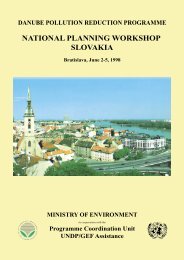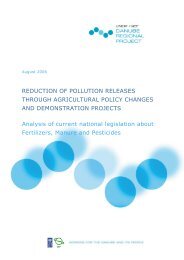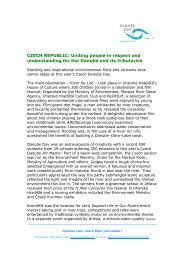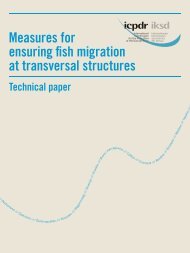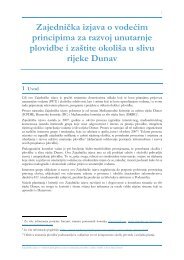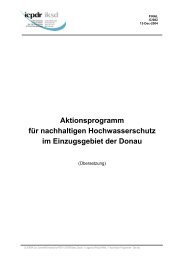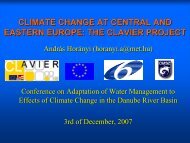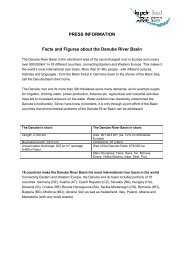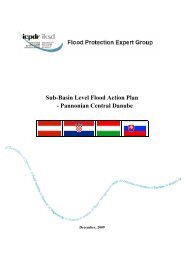Technical Reports Parts C,D - ICPDR
Technical Reports Parts C,D - ICPDR
Technical Reports Parts C,D - ICPDR
Create successful ePaper yourself
Turn your PDF publications into a flip-book with our unique Google optimized e-Paper software.
1. Summary<br />
1.1. Updating, Evaluation and Ranking of Hot Spots<br />
For many years the human pressure on water quality of the Danube River itself and rivers and<br />
streams of its basin exceeded the limits, within which the sustainable functioning of ecosystems of<br />
the Danube River basin occurred. Deteriorated water quality affected many water uses, especially<br />
human health and recreation.<br />
The Danube Environmental Programme launched in 1991 consolidated efforts of riparian countries<br />
directed toward improvement of the Danube water quality, harmonization of approaches to water<br />
management and water quality assessments. Strategic Action Plan was an important step to<br />
implementation of the common strategy from country to country.<br />
Economic crisis in most of post-Soviet countries mitigated the impact of human activities on the<br />
environment of the Danube River Basin resulting in large-scale experiments on ecosystems of the<br />
region.<br />
Rather realistic expectations of pollution reduction became partly true but not to the extent<br />
proportional to decrease of industrial and agricultural activities in Ukraine. For example pesticide<br />
load per ha in Ivano-Frankivsk region decreased almost by 10 times. By twenty percents decreased<br />
the areas of cultivated lands. Transition to market economy and slow transition from state to<br />
private land ownership imposed political problems.<br />
Existing municipal sewer systems and wastewater treatment plants as a rule are overloaded and<br />
have outdated technological equipment. Poor maintenance of technological equipment results in<br />
frequent accidents with significant discharge untreated wastewater directly in the river of the basin.<br />
The Danube riverbed is enriched by plants and animals that live and develop in the river, first of all<br />
in pelagic zone. The total volume of the plankton flow, besides nutrients, determines the efficiency<br />
of the mouth of the delta, the scale of influence on the Black Sea. The average annual volume of<br />
this flow at the top of the delta is about 1.340.000 tons, of which bacteria make up 80,8 %,<br />
phytoplankton – 11,1 % and zooplankton – 8,1%.<br />
The zone of direct influence of Danube waters on the Black Sea is selected on the boundary of<br />
detection of freshwater algae, which continues to grow in marine water. Depending on the estimate<br />
of the river runoff, the area of the zone varies and the maximum size of the surface of the pelagic<br />
zone reaches 100.000 km 2 .<br />
The increasing of diversity, density and biomass of hydrobionts in the zone of transformation in<br />
comparison with adjacent areas can be considered as a manifestation of “edge effect” on the<br />
boundary of coexistence of brackish water and marine fauna. Usually in this zone total biomass and<br />
production of hydrobionts are higher by 2-5 times.<br />
Regular blooming of the sea in a surface layer up to a depth of 10 m has been noted. The total<br />
phytoplankton biomass is more than 400.000 tons on an area about 40.000 km 2 in the summer time.<br />
Among the animal population of the ecoton “river-sea” - there is an absolute prevalence of<br />
noctiluca, Noctiluca scintillans, making up to 90 % of the density and biomass of pelagic<br />
organisms. In 1988 to the south from Sfintu Gheorghe branch on an area about 3.400 km 2 super<br />
high biomass of this organism (125-560 kg.m 3 ) was registered.<br />
The comparison of quantitative measurements of distribution of hydrobionts from the Danube<br />
riverbed up to the sea allows to state the following conformity to natural laws: on the average, the<br />
biomass of hydrobionts is 5-10 times higher in the sea than in the river (phytoplankton - 4,8<br />
times, mesozooplankton - 4,3 times, macrozoobenthos - 8,1 times); in delta water bodies lower<br />
numbers and biomass of hydrobionts have been observed in comparison with adjacent zones - river<br />
branches and sea-coast.



